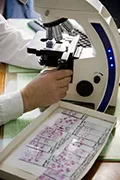Mesothelioma Biopsy
A biopsy is a crucial diagnostic procedure
doctors use to detect mesothelioma. They are performed to determine
whether a suspicious lesion is cancerous and can also be useful when
trying to distinguish a specific type of cancer. Performing a biopsy is
one of the most definitive ways to ensure an accurate diagnosis of
asbestos cancer.
During this procedure, a surgeon removes a tissue or fluid sample for analysis. A pathologist
then views the sample’s cells under a microscope, which reveals their
features, activity and interactions. Biopsies can also prove when cancer
is not the correct diagnosis.
Analyzing biopsied cells is a highly accurate method for diagnosing mesothelioma.
The type and location of a patient’s tumor dictates which procedure should be performed. Peritoneal mesothelioma patients commonly undergo a fine-needle aspiration biopsy, while a thoracoscopic biopsy is more effective for patients with pleural mesothelioma. Because 75 percent of all asbestos cancer cases involve the protective layer of the lungs, the majority of patients undergo thoracoscopies.
Talk to a Doctor About Your Biopsy Procedure
We can help you or a loved one get a diagnosis or a second opinion from a mesothelioma specialist.Thoracoscopy

A VATS biopsy requires only one small incision at either of the locations pictured above.
Several studies reported that a thoracoscopy can make an accurate diagnosis in up to 98 percent of asbestos cancer patients. Direct examination of the pleura may also help with determining cancer stage and the patient's prognosis.
In a 2008 postmortem study of 45 malignant mesothelioma patients, researchers compared the accuracy of several biopsy techniques, including open pleural biopsy, closed needle biopsy and computer tomography (CT)-guided biopsy. The open pleural procedure displayed the highest diagnostic accuracy, confirming a diagnosis in 95 percent of patients with the disease.
Other Types

- Fine-Needle Aspiration -- A quick and safe procedure, fine-needle aspiration (FNA) biopsies use a long, hollow needle to remove up to 10,000 sample cells for testing. This procedure is preferred for its ability to access hard-to-reach areas without the need for anesthesia. FNA biopsies of a pleural or peritoneal effusion can diagnose mesothelioma with an accuracy of up to 84 percent.
- Thoracentesis -- This procedure uses a hollow needle to extract fluid and air from the space between the lungs and pleura. While it is commonly used to remove excess fluid that causes pain and weakens lung function, thoracentesis can also be used to obtain fluid samples for analysis.
- Thoracotomy -- A thoracotomy is a type of invasive surgery used to access the lungs, heart, aorta, diaphragm and trachea. For mesothelioma patients, a segmentectomy, or wedge resection, is the preferred type of thoracotomy since it leaves most of the affected lung intact. During the surgery, a wedge-shaped piece of the lung is removed to be tested by a pathologist for cancer.
- Endoscopic Biopsy -- An endoscopic biopsy is one of the most common biopsy techniques. This procedure uses an instrument called an endoscope that allows the surgeon to see into the area being sampled. Small forceps attached to the endoscope are used to collect slivers of tissue from a potentially cancerous tumor.
- Incisional (Core) Biopsy -- During an incisional biopsy, only a small section of suspicious tissue growth is removed. This is a common procedure when the tumor is easily accessible. Unfortunately, mesothelioma tumors typically do not develop in easy-to-reach locations.
- Excisional Biopsy -- In an excisional biopsy, the entire lesion is removed rather than a small tissue sample. This procedure can eliminate the need for a second removal surgery if testing shows the tumor is malignant.
No comments:
Post a Comment